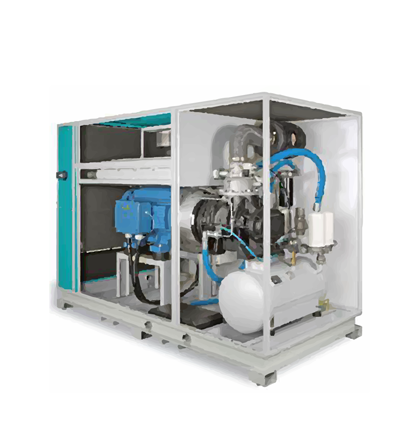Compressed air systems
Looking for an energy-efficient compressed air system?

Small- and medium-size manufacturing facilities across Canada use compressed air systems every day to deliver clean, dry, stable air at specific pressures to power tools and machines.
If your business runs a compressed air system, your goal should always be to deliver the right amount of compressed air at the right pressure and at the lowest cost. Improper use of or failure to maintain such systems can add up to big energy costs over the long run.
Compressed air systems and energy efficiency
Compressed air systems are expensive to operate. It generally takes 7-8 horsepower of electrical energy to produce one horsepower of effect at the point of use. Energy efficiency throughout the system is therefore vital.
Take a careful look at your business’s systems and the ways they use compressed air to find energy-saving opportunities.
Start by considering how and why your business uses a compressed air system. Look for wasteful practices and unsafe operations as well as ways to save on operating costs.
Next, audit your air-distribution hardware. Even small leaks and pressure losses across piping, tubing, valves, hoses, filters, quick connectors and other transmission devices can create big losses and are easy targets for repair.
Finally, review your business’s production and cleanup practices and tools. Improperly sized compressors, compressor control systems and air dryers are hugely energy inefficient.
For a comprehensive guide, download NRCan’s Compressed Air: Energy Efficiency Reference Guide [PDF - 4.6 MB].
Buying tips
Operating costs are big factor.
When buying a compressed air system, bear in mind that the unit’s purchase price is one of the smallest components of its lifecycle costs. Energy efficiency then becomes even more important in reducing the costs of running the machine.
Consider the service factor.
A compressor’s service factor is the measure of how much a motor can operate beyond maximum capacity without overload or damage. Compressors can be, and often are, run at loads higher than their stated ratings—a fact that contributes to increased energy usage.
Match operating pressures.
Compressor systems function best when the operating pressures of its component parts match.
Build in margins for error.
Buy a compressor that meets your peak load plus an extra 20 to 30 percent for growth.
Size affects reliability.
Two smaller compressors run in parallel may be able to handle the same load as a single, large compressor. What’s more, such a system will be less prone to failure (since compressors occasionally fail) and cost less to operate.
Consider electronic pressure controls.
Some compressed air systems feature electronic pressure controls that can automatically and accurately establish system pressure.
Choose the right cooling medium.
All compressed air systems require cooling, and different cooling methods consume different quantities of energy. Choose the medium that strikes the right balance between efficiency and effectiveness for your business. Air-cooled systems need large supplies of fresh clean air to function; water-cooled systems continuously intake large quantities of fresh water. Depending on resource costs in your area, one method may be more cost effective than the other.
Go low.
Buy a low-pressure system for tools that do not require as much pressure to operate.
Service the air dryer.
An efficient air dryer can significantly reduce energy load by drying only as much air as is needed.
Operating tips
How you run a compressed air system affects energy efficiency as much or more than the energy efficiency of the system’s component parts. Consider the following tips for getting the most out of your system.
Find and fix leaks.
A 3/8-inch leak can cost tens of thousands of dollars in wasted energy annually (for a system delivering 100 cubic feet per minute (cfm) at 125 psi over a year.) Invest in leak detection equipment, tag leaks and fix them quickly.
Consider the operating mode.
A compressor’s operating mode significantly affects its energy consumption. Choose the mode that delivers enough power for the job at hand.
Lower the operating pressure.
A decrease in operating pressure by as little as two psi reduces energy use by one percent. Make sure you and your colleagues know the exact pressure requirements for each job and operate compressors accordingly.
Keep the heat.
Four-fifths of the energy consumed by a compressor is converted into heat. Look into heat recovery technologies that can capture that heat for applications such as process heat, space heat or even hot water.
Examine the air dryer.
A compressor’s air dryer consumes as much as one fifth of the unit’s total power. Check your unit’s air dryer for efficient, correctly sized dryers.
Check condensate drains.
Save money by replacing older condensate drains with more energy-efficient units.
Page details
- Date modified: